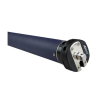
More and more people are deciding to install automatic outdoor awnings or to motorize existing awnings . But finding the awning motor that best suits your needs is not as simple as it seems.
To automate awnings, you need to insert a tubular motor (so called because of its shape) inside the tube on which the arm or roller awning is wound. Control can take place in the immediate vicinity via a simple wall button, or remotely via radio with a portable radio control.
In a wired system, the control is connected to the tubular motor via electrical cables, which transmit the commands to the motor. The control unit can be integrated into the motor or positioned nearby. In a radio system , however, the commands are sent via radio waves, eliminating the need for electrical cables between the motor and the control device.
Before choosing the motor and control system for your motorized awnings, it is important to gather some basic information.
To begin, measure the diameter of the roller on which the awning rolls: the size of the roller will influence the model of motor to be used, and in some cases it may require the use of specific adapters. Also, take note of the maximum projection of the awning , whether it is a roller, pergola or hood, and check the number of arms of the structure.
Although awning motors all require a power of 230V , there are many differences between the various models. An important aspect is the diameter of the tubular motor , which must always be smaller than that of the roller, since it will have to be inserted inside it.
In addition to this, it is essential to choose the type of control that best suits your needs: you can opt for a simple wall button near the awning or for a remote control that allows you to operate the awning from other rooms in the house.
Technology has greatly improved awning automation systems. Today there are wireless solutions that allow you to connect a mini radio receiver to the tubular motor, allowing you to control the awning with a remote control without having to install cables or carry out masonry work.
In addition, it is possible to integrate sun-wind sensors into the motorized system. These sensors automatically adjust the opening and closing of the awning based on weather conditions, ensuring maximum comfort without the need for manual intervention.